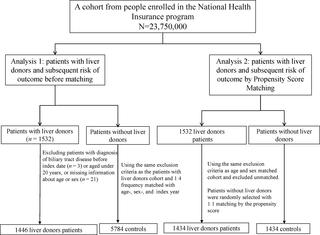PLOS ONE ( IF 3.7 ) Pub Date : 2020-03-30 , DOI: 10.1371/journal.pone.0230840 Shih-Yi Lin , Cheng-Li Lin , Wu-Huei Hsu , I-Kuan Wang , Cheng-Chieh Lin , Long-Bing Jeng , Chia-Hung Kao

|
Background & aims
Whether living liver donors have a higher risk of biliary tract disease compared with non-donors remains unknown.
Methods
Data were collected from the Taiwan Longitudinal Health Insurance Database for the 2003–2011 period. The study cohort comprised 1,446 patients aged ≥ 18 years who had served as living liver donors. The primary outcome was the incidence of biliary tract disease. Cox proportional hazards modeling was used to determine the hazard ratios.
Results
The incidence density rate of biliary tract disease was 13.9-fold higher in the liver donor (LD) cohort than in the non-LD cohort (10.2 vs. 0.71 per 1,000 person-years), with an adjusted hazard ratio (HR) of 14.2 (95% confidence interval [CI] = 7.73–26.1). Stratified by comorbidity, the relative risk of biliary tract disease was higher in the LD cohort than in the non-LD cohort for both patients with or without comorbidity. The incidence density rate of biliary tract disease was significantly higher in the first 3 years (13.5 per 1,000 person-years in the LD cohort). The highest adjusted HR of biliary tract disease for LD patients compared with the non-LD cohort was 22.4 (95% CI = 10.8–46.1) in the follow-up ≤ 3 years.
Conclusion
Living liver donors had a higher risk of biliary tract disease compared with non-donors.



























 京公网安备 11010802027423号
京公网安备 11010802027423号